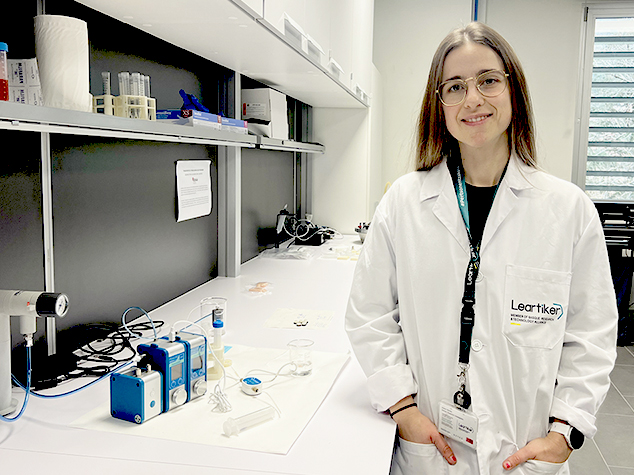Femtosecond laser for the development of microfluidic devices
Innovation and development in the biomedical field are fundamental pillars for Leartiker's Health area, which is focused on the search for new alternatives in the field of biomedicine. Through advanced research and collaboration with other researchers and professionals in the sector, Leartiker seeks to improve the quality of patients by generating knowledge to contribute to current demands and trends where less invasive and more personalised and effective treatments are prioritised.
In this sense, our researcher in the Health area, Irene Varela, is currently immersed in her doctoral thesis which aims to study and develop new approaches for precision micromachining technologies for the mass production of thermoplastic microfluidic devices. This research work is being carried out in collaboration with the Macromolecular Chemistry research group of the Department of Physical Chemistry of the Faculty of Science and Technology of the University of the Basque Country (UPV/EHU).
The research team is currently studying the potential of femtosecond laser technology for the micromachining of microfluidic structures in metal moulds for the upcoming large-scale production of these devices by injection moulding.

A technology with high potential for microfluidics
As an added value of the technology, femtosecond lasers have also shown great potential for generating textured surfaces in a cost-effective way to create functional surfaces. This is of great interest for various biomedical applications, and it is believed that it could foreshadow high potential in microfluidics, in particular for organ-on-chip applications. Textured microfluidic channels could promote and/or enhance cell adhesion and proliferation functions in organ-on-chip devices.
In view of this possibility, the research team is analysing the potential of laser texturing to generate functional surfaces following the same mass production strategy as previously proposed. Work is underway to characterise changes in the surface properties of textured polymer replicas, such as changes in surface roughness or wettability properties.
In addition, detailed studies are being carried out in Leartiker's biomaterials and microfluidics laboratories using different cell types to assess the impact of the enhanced properties of femtosecond laser-generated textured surfaces. The aim is to determine whether these specific features can promote increased cell adhesion and proliferation.
Fast and cost-effective clinical diagnostic tools
To date, the most commonly used microfluidic mould fabrication techniques can hardly meet the demanding requirements of more complex devices, and if they do, the cost is very high, which in turn translates into a high price for marketable devices. This makes it difficult for end-users to accept them.
The development of new fabrication processes would represent a significant advance in the state of the art for the creation of microfluidic devices in general, but specifically for the development of new medical tools. The development of microfluidic devices is essential to develop rapid and cost-effective clinical diagnostic tools, anticipating a new revolution in the medical and healthcare fields.
Therefore, achieving the proposed objectives will not only have a significant impact on the microfluidic device industry, but is also expected to have a major impact on the healthcare sector, accelerating the development of new key diagnostic tools and reducing their costs to make them more accessible to patients, thus contributing to improving the quality of human life.

